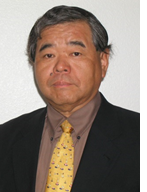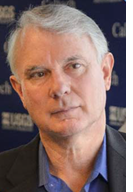Total of four keynote presentations will be held during the Workshop:
Risk-, Resilience- and Sustainability-Informed Decision Making for Bridges in a Life-Cycle Multi-Objective Optimization Context

Dan M. Frangopol
The Fazlur Rahman Khan Endowed Chair of Structural Engineering and Architecture
Professor of Civil Engineering, Department of Civil and Environmental Engineering,
ATLSS Center, Lehigh University, Bethlehem, PA 18015-4729, USA
http://www.lehigh.edu/~dmf206
BIO: Dr. Dan Frangopol is the inaugural holder of the Fazlur R. Khan Endowed Chair of Structural Engineering and Architecture at Lehigh University. Before joining Lehigh University in 2006, he was Professor of Civil Engineering at the University of Colorado at Boulder, where he is now Professor Emeritus. In 1976, he received his doctorate in Applied Sciences from the University of Liège, Belgium. He is recognized as a leader in the field of life-cycle engineering of civil and marine structures. His main research interests are in the application of probabilistic concepts and methods to civil and marine engineering including structural reliability, probability-based design and optimization of buildings, bridges and naval ships, structural health monitoring, life-cycle performance maintenance, management and cost of structures and infrastructures under uncertainty, risk-based assessment and decision-making, infrastructure sustainability and resilience to disasters, and stochastic mechanics. Dr. Frangopol is the Founding President of the International Associations for Bridge Maintenance and Safety (IABMAS) and Life-Cycle Civil Engineering (IALCCE). He has authored/co-authored 2 books, 40 book chapters, over 350 articles in archival journals including 9 prize winning papers, and many papers in conference proceedings. He is the Founding Editor of Structure and Infrastructure Engineering and of the Book Series Structures and Infrastructures. Dr. Frangopol is the recipient of several medals, awards, and prizes, from ASCE, IABSE, IASSAR, and other professional organizations, such as the OPAL Award, the Newmark Medal, the Alfredo Ang Award, the T.Y. Lin Medal, the F. R. Khan Medal, and the Croes Medal (twice), to name a few. He holds 4 honorary doctorates and 12 honorary professorships from major universities. He is a foreign member of the Academia Europaea (Academy of Europe, London) and the Royal Academy of Belgium, an Honorary Member of the Romanian Academy of Technical Sciences, and a Distinguished Member of ASCE.
Abstract: Our knowledge to model, analyze, design, maintain, monitor, manage, predict and optimize the life-cycle performance of structures and infrastructures under uncertainty is continually growing. However, in many countries, including the United States, the civil infrastructure is no longer within desired levels of performance. Decisions regarding infrastructure systems should be supported by an integrated risk-, resilence- and sustainability-based life-cycle multi-objective optimization framework by considering, among other factors, the likelihood of successful performance and the total expected cost accrued over the entire life-cycle. The primary objective of this keynote lecture is to present a framework for risk-, resilience- and sustainability-informed decisión making for structural systems and networks in a life-cycle multi-objective optimization context. Risk-based performance metrics allow engineers to combine the probability of structural failure with the consequences corresponding to this event. The sustainability performance metric is established considering the risks associated with economic, social, and environmental impacts, utility theory, and the decision maker’s risk attitude. Applications include time-variant reliability, risk, resilience, and sustainability of bridges, bridge transportation networks, and interdependent infrastructure systems under multi-hazards.

Bayesian uncertainty quantification and sparse Bayesian learning for model updating in structural health monitoring
James L. Beck
George W. Housner Professor of Engineering and Applied Science
California Institute of Technology, Pasadena, CA 91125, USA
http://jimbeck.caltech.edu/
BIO: James (Jim) Beck has been a professor at the California Institute of Technology since 1981 where he is currently in two departments in Engineering and Applied Science: Mechanical and Civil Engineering, and Computing and Mathematical Sciences. The primary focus of his current research is the development of theory and algorithms for stochastic system modeling, uncertainty propagation and Bayesian updating of dynamic systems based on sensor data, treating both modeling and excitation uncertainty. Some applications of current interest are damage detection and assessment based on structural monitoring networks, Bayesian compressive sensing of signals, stochastic predictions of the performance of structural systems under earthquakes, reliability assessment of technological networks, fast automated decision making for mitigation actions based on earthquake early warning systems, and earthquake source inversions from seismic sensor networks. Beck has over 350 research publications in journals, conference proceedings, technical reports and book chapters.
Abstract: The focus in this presentation is model updating based on vibration monitoring of an instrumented structure, especially to detect and quantify localized stiffness losses as a proxy for damage. Because of its ability to quantify modelling uncertainty, a Bayesian approach is used in which the relative plausibility of each model in a model class (based on parameterized set of structural models) is quantified by its posterior probability from Bayes’ Theorem. In addition, the relative plausibility of each model class within a set of candidate model classes can be assessed. Computation of this posterior probability from Bayes’ Theorem over all candidate model classes automatically applies a quantitative Ockham’s razor that is a trade off of a data-fit measure with an information-theoretic measure of model complexity that quantifies how much information is extracted from the data by the model class. Some recent progress in exploring sparse Bayesian learning for structural health monitoring will be covered, in which spatially-sparse substructural stiffness reductions are inferred in a way that is consistent with the Bayesian Ockham razor. Illustrative results show the potential of the presented sparse Bayesian learning algorithms for structural health monitoring.

What We Have Learned from Operational Monitoring and Serviceability Assessment of Long-Span Bridges

Dr. Ho-Kyung Kim
Professor and Chair, Dept. of Civil and Environmental Engineering
Director, BK21PLUS research program
Seoul National University, Korea
hokyungk@snu.ac.kr; http://bridge.snu.ac.kr
BIO: Prof. Ho-Kyung Kim received his doctoral degree at Seoul National University in 1993. His research interests include a reliability-based design, operational monitoring and assessment of long-span cable-supported bridge, and bridge aerodynamics. He served as the director of Korea Wind Engineering Research Center (KWERC) and the director of Extreme Performance Testing Center (EPTC). He is now serving as a correspondent, a member of WG-10 Super-Long Span Bridge Aerodynamics, and international delegate for International Association of Bridge and Structural Engineering (IABSE). He is also serving as the Chair for TC-18 on the Adoption of Standard Operating Procedures for Design, Construction and Maintenance of Long Span Bridges, the Asian Civil Engineering Coordinating Council (ACECC). He is currently serving as the editor-in-chief for KSCE Journal of Civil Engineering, Springer and as an associate editor for Journal of Civil Structural Health Monitoring, Springer.
Abstract: More than 50 cable-supported bridges have been built in Korea since 1980. While maintaining those infrastructures for last 35 years, we have experienced unexpected problems from operational field monitoring of long-span bridges. This paper will discuss on what we have observed, learned and how we responded to those events. As an example, a vortex-induced vibration (VIV) was observed in 2011 in parallel-disposed twin cable-stayed bridges. Operational monitoring and wind tunnel tests successfully identified that the close distance between two bridges was one of the main cause of VIV. However, an operational modal analysis revealed that unexpected low damping ratio of the bridge was also contributed to the realization of this serviceability problem in an operating bridge. Another observation of vibration in a long-span suspension bridge also attracted our attention on the potential low damping ratio, which may invoke serviceability issues in assessment of bridges. This paper will introduce the details of the cause investigations, assessment and mitigation of the serviceability problems, validation through field tests and operational monitoring, and concluding suggestions to bridge owners and engineers.

New Technologies for Condition Assessment of Existing Structures

Hitoshi Furuta
Department of Informatics, Kansai University
2-1-1 Ryozenji-cho, Takatsuki, Osaka 569-1095, Japan
Email: furuta@res.kutc.kansai-u.ac.jp
BIO: Dr. Hitoshi Furuta is a Professor in the Department of Informatics at Kansai University, Osaka, Japan. In 1980 he received his doctorate in Engineering from Kyoto University, Japan. Before joining Kansai University in 1993, he worked for eighteen years in the Department of Civil Engineering at Kyoto University. His main areas of expertise are structural reliability, structural optimization, life-cycle cost analysis and design of bridge structures, and applications of soft computing including artificial intelligence, fuzzy logic, neural network, chaos theory, and genetic algorithm. Hitoshi Furuta has chaired and organized several international structural engineering conferences. In 2009, he was the chair of ICOSSAR2009 held at Osaka. He is the chair of IABSE WC1 and vice president of IALCEE.
Abstract: In Japan, a new project called “Cross-ministerial Strategic Innovation Promotion Program (SIP)” supported by Japanese government has started three years ago, one of which deals with the innovative technologies for maintenance, renewal and management of infrastructures. In this program, 60 new technologies have been developed using IT, sensor and material engineerings. Representative technologies developed herein will be introduced by paying attention to the condition assessment of existing structures. In addition, an attempt is made to introduce the application of chaos theory into structural damage assessment in non-destructive inspection and vibration-based health monitoring. Firstly, a new impact acoustic method based on attractor analysis is described, which can improve the accuracy of conventional methods of investigating the frequency domain. The proposed method detects exfoliations and confirms the filling conditions inside steel-concrete composite slabs by evaluating the difference of convergence processes of attractors reconstructed from acoustic signals. The effectiveness of applying chaos theory to structural damage assessment is discussed through field experiments and numerical simulations.

 Pristupačnost
Pristupačnost